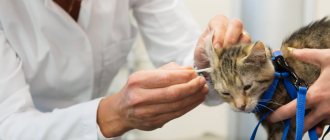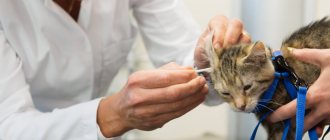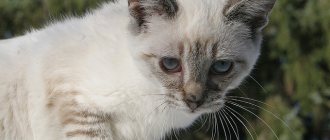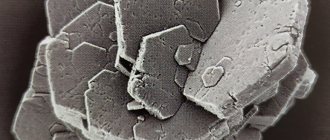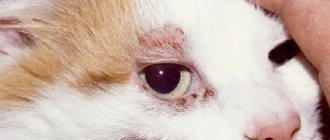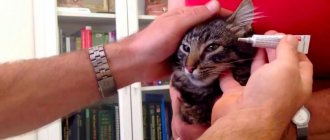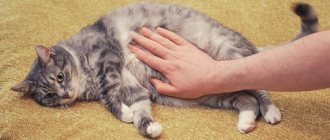Features of the disease
Discharge from the nostrils and eyes is one of the signs of distemper in cats.
Feline distemper, or panleukopenia, is a highly contagious disease. The clinical picture depends on the type of disease, but always manifests itself with fairly clear signs. This is due to the rapid multiplication of the virus in the body, the speed of which largely depends on the state of the immune system. The most vulnerable felines are kittens, pregnant and weakened cats, as well as purebred pets.
The virus that causes distemper in domestic cats is highly resistant to external factors. It can tolerate low and high temperatures; even heating to +60 ˚C can destroy it only after 60 minutes. Disinfectants also cannot destroy pathogenic microorganisms, especially if they are diluted in low concentrations.
What happens during an illness?
Once in the body, the virus infects the cells of the mucous membranes of the nasopharynx, replicates (multiplies) and spreads throughout the body, affecting certain types of cells (most often dividing cells): primarily the crypts, which form the mucous membrane of the intestinal tract.
The virus causes cell destruction, disruption of the function of tissues formed by these cells, and as a result, complete destruction and desquamation of the intestinal mucosa. In addition, viral particles affect cells of lymphoid tissues (lymph nodes, spleen, thymus) and red bone marrow (hematopoietic function is inhibited). The virus destroys lymphocytes, white blood stem cells, which leads to disruption of the body's immune system.
How can a cat become infected with distemper?
There are several ways a cat can become infected with the distemper virus. In each of them, the source is the biological secretions of an already sick animal or a carrier of infection.
Infection method
Detailed description
Direct contact
A pet can “catch” the disease by directly touching objects that the sick animal has come into contact with. The virus can enter the house and on the owner’s belongings.
Oral route
Distemper infection will also occur if you eat food or drink that contains the infection.
Through the air
If a healthy cat is in the same room as an infected one, then panleukopenia cannot be avoided.
Through bites
Blood-sucking insects are capable of transmitting the feline distemper virus.
In utero
The feline distemper virus is able to cross the placental barrier. In most cases, fetuses die before birth. If the kittens succeed in being born, then in the near future (no more than two days) they still die.
Many owners are interested in whether a cat can get distemper from a dog? No, he can not. The viruses that cause plague in these animals are completely different.
What is feline panleukopenia?
“Chumka” is a popular name. This is the name given to various infections that are characteristic of different types of animals, but have common features - they are very contagious, sick cats often die or have a difficult recovery. In addition, cat distemper is sometimes similar in its course to canine distemper, to which dogs are susceptible. Until 1928, it was even believed that these were the same disease, but their pathogens were different, and cats did not get canine distemper, and vice versa.
The causative agent of the disease is the Panleukopenia feline virus , which belongs to the parvovirus family. Veterinarians and virologists call feline distemper panleukopenia, or infectious gastroenteritis.
The first scientific name describes a characteristic symptom of the disease - a significant decrease in the number of all types of leukocytes in the animal’s blood. The second is a set of symptoms noticeable to the owner: this is an upset stomach and intestines, moreover, caused by an infection, that is, contagious.
It would seem, how is the decrease in the number (up to complete absence!) of leukocytes in the blood connected with inflammation of the gastrointestinal tract? The fact is that the causative agent of panleukopenia needs cells that divide as quickly as possible to reproduce. And these are bone marrow cells, especially those that produce leukocytes (at first the virus causes accelerated production), epithelial cells of the stomach and intestines, fetuses and newborn kittens. But since division is a process characteristic of cells of any tissue of a living organism, the disease actually affects all organs.
How does distemper manifest in cats?
The feline distemper virus can infect almost all organ systems: nervous, respiratory, cardiovascular, and digestive tract. Symptoms of the disease depend on which organs the microorganism has managed to damage, on the capabilities of the cat’s immune defense, as well as on the form of the disease, which can be of three types.
Form of the disease
Peculiarities
Symptoms
Lightning fast
It has a particularly high mortality rate as it develops quickly. It is observed mainly in kittens of the first year of life. The smaller the kitten, the faster it dies. The fulminant form is often manifested by disorders of the nervous and digestive systems.
- Refusal to suck, food, water
- Apathetic state
- Avoiding bright light and sharp sounds (when they occur, it begins to squeak loudly)
- Diarrhea, vomiting
- Tousled fur
- Body tremors, convulsions
- Paralysis
Acute
More common in adult cats. The incubation period ranges from 3 to 10-14 days. The clinical picture is varied and depends on the number of affected organs. Mainly the gastrointestinal tract, respiratory system, and heart are affected. With timely contact with specialists and proper treatment, the pet can recover. If no help is provided to the animal in the next 3-5 days after the onset of symptoms, it will die.
- Apathy
- Temperature rises to 41˚
- Vomit contains blood, mucus, and foam
- Despite being thirsty, the cat refuses to drink water
- Skin spots
- Cough, wheezing
- Discharge from nostrils, eyes
- Tachycardia
- Shortness of breath, mouth breathing
- Sunken eyes, tousled, dull coat
Subacute
It is typical for adult mustachioed individuals and cats that have been vaccinated against distemper. The disease may last for 1-3 weeks.
The same as in the acute form of plague, but in a less pronounced form.
Symptoms and signs of panleukopenia (feline distemper)
With plague, secondary infections may appear, for example, bacterial (she is in the photo)
It is these places that distemper affects, causing serious harm to the cat’s immune system. The body becomes unable to sufficiently protect the cat from surrounding infectious agents, and other problems may be superimposed on the disease - concomitant infections, secondary infections caused by a decrease in the body’s supporting ability and the “overgrowth” of the body’s natural microflora in the ears, intestines and other places where they live.
Dormant infections
With a decrease in the level of protection, dormant infections can “wake up” - most cats are carriers of viruses that do not make themselves known until the cat’s body is weakened and favorable conditions are created for their activity.
Complication of herpes in a cat, which is caused by distemper
The severity of the symptoms and the severity of the animal’s condition depend on many factors: age, conditions of detention, the strength of the immune system, the strength of the pathogen itself.
- Non-specific symptoms of the disease appear: high fever, depression, refusal to feed.
- Specific symptoms of the disease are signs of damage to the gastrointestinal tract. These signs include vomiting and diarrhea. Vomit may contain mucus and blood. The stool becomes loose and foul-smelling, and blood clots may also appear. The color of the urine changes and becomes dark or orange.
Sick cats instinctively seek shelter
Sick cats instinctively seek shelter - they will hide in hard-to-reach places. They may often want to lie down on something cold; this behavior is associated with high fever.
Therapeutic measures
At the first symptoms of distemper, we recommend immediately contacting a veterinarian
Treatment of distemper in cats includes several tasks: destroy the virus, eliminate intoxication, prevent secondary infection, increase immunity, and so on. To combat the virus, drugs such as Vitafel, Fosprenil, Enterostat are used. The administration regimen is prescribed by the veterinarian.
Various drugs are used as a symptomatic treatment for distemper in cats.
- Sodium chloride. The distemper virus causes severe dehydration and intoxication. The body cannot cope with toxins on its own. Intravenous administration of a chloride solution helps restore the balance of water, salts, and minerals.
- As a rule, distemper in cats is accompanied by a secondary infection. To eliminate it, the veterinarian will prescribe antibacterial agents.
- Diuretic fees. To quickly cope with toxic metabolic products and remove them from tissues and the body, decoctions of diuretic herbs and herbs are used. In frequent small portions, you can give your cat a decoction of lingonberries, horsetail, bearberry leaf and others.
- If there is no vomiting, it is recommended to use Regidron or Ringer's solution to normalize the water-mineral balance. The daily amount of solution is calculated based on the ratio of 5 tbsp. l. liquid per 1 kg of animal weight. You can add glucose solution and sodium bicarbonate to the diluted drugs (the proportions must be checked with your veterinarian).
- For pain and spasms in the digestive tract, taking antispasmodics, for example, No-shpa, is indicated.
- Catozal will help strengthen metabolic processes, improve immunity, and stimulate the body to recover. It must be administered within 7 days.
- The treatment complex also includes vitamin supplements, especially antioxidants A and C, and B vitamins. It is advisable to combine their intake with drugs containing iron, for example, Ferrodextran.
How is panleukopenia diagnosed?
The diagnosis of panleukopenia can only be made by a veterinarian. This disease is similar in symptoms to leukemia, poisoning and immunodeficiency, so the owner must tell the specialist in as much detail as possible about all changes in the animal’s behavior. The veterinarian will collect all the necessary medical history and rule out other diseases with similar symptoms. In addition to the medical history, the doctor will give a referral for a general urine test, a general blood test, biochemical analysis, stool analysis, and bacteriological examination. As soon as the data is ready, he will prescribe treatment.
Home care
Proper care at home for a cat with distemper increases the likelihood of a successful recovery. If possible, it is better to give injections by calling a doctor at home, since any stress can negatively affect the animal’s condition. If you have to visit the clinic every day, then for transportation it is better to build a basket yourself (for example, from a cardboard box), so that you can burn it later.
The room where the cat is located should be warm and dry, without draft wind. Since the virus also affects the nervous system, you need to provide your pet with peace and shade with bright light.
You can drink both plain water (boiled) and decoctions of medicinal herbs. Their choice should be previously agreed with your veterinarian, because some medications and plant extracts may be incompatible. You need to feed your pet little by little, at the beginning of treatment - only broths, gradually adding porridge and chopped meat to them. It is recommended to follow a diet until complete recovery.
In agreement with the doctor, it is allowed to give the cat enemas. They may include herbal preparations, decoctions, and antiseptics. The tray and bowls should be placed next to the animal, and the bedding should be changed daily. Washing your pet while sick is not recommended.
What symptoms might there be? 12 signs that a cat has distemper:
Everything here is typical and easily recognizable. When distemper is detected in cats, symptoms and treatment may be as follows:
- The cat is coughing. Not too persistently, but with enviable frequency, while her cough is dry. This symptom accompanies the pet throughout the entire illness. (but it is also worth noting that cases have been identified where it may be absent altogether).
The eyes begin to fester. Pus accumulates in the corners. The eyes take on a bloody color.
The cat has a hot and dry nose.
There is nasal discharge.
There is an unpleasant smell from the mouth.
The pet suffers from diarrhea.
There is a sharp increase in temperature.
The cat's state becomes apathetic, he is sad and is not interested in anything.
There is a tendency to solitude. The pet tries to hide in some dark place.
Doesn't eat anything.
The cat is shaking violently.
What to do after the appearance of symptoms indicating this disease
When signs of distemper appear in cats, the first thing you need to do is stop feeding them. Find a warm, quiet place and put her there. Avoid stuffy rooms. Because fresh air is very necessary when a cat is sick with the plague. Because in its absence, pulmonary complications will occur.
Distemper in cats is a very serious disease; you can read the information provided on various practices for informational purposes only. Self-medication is highly discouraged. The entire range of necessary measures must be taken by a veterinarian in a veterinary clinic.
There are opinions that it is necessary to give special herbal antiseptic tablets 2 times a day, in the morning and in the evening. Such pills can be made with your own hands to treat plague at home.
How to make such a tablet? Recipe for making distemper medicine for cats:
Take garlic. Mixed with honey. Then mixed with a very small amount of flour. Better than wheat.
How to treat distemper in cats using herbs and folk methods?
During treatment, you need to clean your pet’s mouth and teeth in the morning and evening. To do this, you need to dilute lemon juice (weak concentration). 1 tsp juice to 2 dessert spoons of water.
You need to give it in the morning, a few tablespoons. Accumulated discharge from the nose and eyes is removed with cotton wool. swab, which should be soaked in an infusion of the following herbs:
- Rosemary plant
Annual plant Alzina
Veronica plant
Elder flowers
Balsam
When there is irritation of the nose and eyes, it is necessary to treat it with almond oil (it must be free of impurities).
Try giving your cat honey water. If he wants it, let him drink the regular one, while making honey balls. The honey, of course, must be thick, otherwise it won’t work. Push them down your pet's throat. If he is not currently on a fasting diet.
Honey itself does not affect digestion, as it is quickly absorbed into the blood.
The moment will come when the cat's inflammation will disappear. After this, internal cleansing treatment can be undertaken. And prescribe a natural diet.
But what should you do if your cat’s inflammation goes away, but the diarrhea does not go away?
In this case, you need to add crushed tree bark to the milk. This is done in order to soften the cat’s gastrointestinal tract and provide it with light food. For every cup of wood meal that is made from the bark, you need to add a teaspoon at the tip. cinnamon.
A situation may arise when, at a normalized temperature, the animal refuses to eat. In this case, inflammation may resume. And then, you need to go without food for quite a long time. That is, it turns out to be a kind of therapeutic fasting.
How to give honey to a cat?
You need to give it 3 times a day. Accordingly, in the morning, afternoon and evening. At 8, 12 and 19 o'clock. If you notice that your cat has begun to recover, you can try giving apple juice. Little by little, one or two tsp. will be quite enough. Drink in the morning and evening.
Can other animals or humans become infected with feline distemper?
Is a pet with panleukopenia dangerous to others? Cats after distemper are carriers of the virus for 4-5 months and can become its source, but only a feline can become infected. The mustachioed friend poses no danger to surrounding people and pets.
The virus, which is carried by a recovered cat, is released into the external environment with biological fluids, so throughout the entire period of carriage the pet should not be allowed to leave the house. The cat itself acquires immunity to the plague for a long period, sometimes until the end of its life.
Caring for a sick kitten with distemper
Care plays a huge role in the animal's recovery. Treatment combined with the attention and care of the owner is the best option. The owner needs to know how to properly care for a kitten:
- The room should be dry and warm. Ventilation of the room is mandatory. Moreover, the kitten must be protected from drafts and avoid hypothermia.
- Keep the tray free of feces and urine. If there is vomit, also try to remove it quickly. Excretion from the body can become a dangerous source of persistence of the virus, and we need to achieve less contact between the animal and it, since it can re-cause infection.
- Discharge from the eyes and nose is removed twice a day. This is done using special solutions and drops prescribed by a veterinarian.
- Keep the room where the sick kitten is kept clean. Do wet cleaning more often. Sodium hypochlorite is added to the washing water as a disinfectant. Experts advise doing this twice a week. The room must be washed with plain water daily.
- It is prohibited to force feed an animal. During illness, the body is exposed to intoxication, so it is normal when the animal does not feel like eating. It is better for a kitten to cope with the disease by fasting a little. A good sign is the emergence of an interest in food. This indicates that recovery has begun. At the time of illness, the animal needs complete rest. The kitten itself will understand when to eat and drink. It is prohibited to interfere with this process! The owner needs to leave some food and water near the animal, while monitoring their freshness.
- An animal cannot eat everything. The body is still completely weakened. The veterinarian will prescribe a diet to follow. Lean meats, dietary broths, and cottage cheese are suitable. Fish and fermented baked milk are given later.
- A bowl of food and water and a tray are located next to the kitten. The animal is weakened, therefore unable to walk and experiencing weakness.
- If there are small children in the family, then try to isolate the kitten from their attention.
If such a serious problem as panleukopenia in kittens occurs, emotionally support the animal. Stroke him, caress him, talk gently. The animal listens to the intonation of the owner’s voice and understands everything. Love and care will do their job and your pet will recover faster. Be sure to contact your veterinarian for treatment.
Prevention of plague
Don’t forget about vaccination, and the risk of getting distemper will be minimized
The most effective preventative measure for feline distemper is vaccination. Since there are currently enough vaccines, the doctor chooses at his own discretion. The following drugs are popular: Nobivak, Multifel, Feleniffa.
Kittens are first vaccinated at 1.5-2 months, and after 3-4 weeks they are revaccinated. Subsequently, the vaccine is administered once a year.
You can prevent a deadly disease by not letting newborn kittens go outside, preventing your pets from escaping and interacting with unfamiliar family members. In addition, it is necessary to monitor the immune system of your mustachioed friend, providing the cat with adequate nutrition and vitamins.
Features of the course of panleukopenia in kittens
The disease is particularly dangerous even for adult animals, and among kittens the mortality rate reaches 90%. This is due, firstly, to the imperfection of the kitten’s immune system, secondly, to the body’s low resources, and thirdly, to the general immaturity of all organs and systems.
In kittens, the disease occurs in the vast majority of cases in an acute or even fulminant form. With the latter, the disease progresses in a few hours or less and always ends in death.
Owners may notice acute onset of diarrhea, and then the death of the animal occurs. In this case, all kittens that came into contact with the deceased are in danger, and it is necessary to urgently take preventive measures.
If a kitten in a litter suddenly dies, the first thing to be wary of is panleukopenia and start treatment for it. Once symptoms appear, it will most likely be too late.
